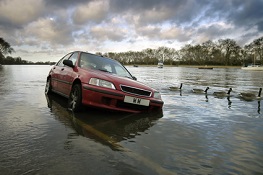 Its first name was Tropical Depression 18, and it was born last year in the morning hours of Oct. 22 in the Caribbean.
Its first name was Tropical Depression 18, and it was born last year in the morning hours of Oct. 22 in the Caribbean.
By the end of the day, it was renamed Tropical Storm Sandy, and what would come to be known as a superstorm was heading for landfall on the eastern seaboard of the U.S.
It would take more than a week after that for Sandy to dissolve, leaving in her wake a mess of damaged cars that had sloshed around in floodwater alongside boats, homes and debris.
According to Property Claim Services (PCS), damaged vehicles accounted for 16 percent (or 250,500) of the total 1.52 million claims submitted after Superstorm Sandy. Of the $18.75 billion in total insured losses from those claims, auto claims accounted for 15 percent, or $2.7 billion, according to a report from the Insurance Information Institute.
Now, a year later, Online Auto Insurance (OAI) revisits the disaster with industry officials from the Property Casualty Insurers Association of America (PCI) and the Insurance Information Institute (III), both national trade organizations.
Revisit OAI tomorrow, when we will speak to officials from state insurance industries about how they dealt with the disaster.
An Odd Storm Brought Other Oddities
It’s safe to say Superstorm Sandy was an odd disaster. It flooded areas where populations were highly condensed. It came at the tail end of hurricane season.
And it brought with it a handful of other oddities.
Odd claims became commonplace as car insurers sorted through the post-disaster paperwork, according to Michael Barry, spokesman for the III.
“We had instances where boats landed on cars,” Barry said. “And that’s covered under comprehensive, since it’s deemed a falling object just like a tree is.”
Barry said Sandy highlighted the value of comprehensive coverage, which pays for damages to the insured vehicle that weren’t caused by a collision; that includes things like weather damages and vandalism.
“The upside for events like this is comprehensive coverage,” he said. “It came in so handy for so many during this event.”
The disaster also brought a number of bogus towing companies and contractors to residents’ doorsteps, according to PCI senior director of personal lines Robert Passmore, who said fighting off fraud was a major component of recovery efforts.
Even adjusters sometimes had trouble locating damaged vehicles because of unauthorized towing, he said.
“There was a street in NYC where a towing company said that it was told by police to take every car on the street, and other towers came in saying an insurer had told them to tow every car on the street,” Passmore said. “Then they collected charges based on that … Adjusters had their challenges getting to the damaged area, then finding the vehicles was the next challenge.”
Those shady parties were obviously eager, oftentimes showing up even before “police got their roadblocks set up,” according to Passmore.
“Whenever you have a catastrophic event, you always have some bad actors coming onto the scene,” he told OAI. “There are contractors knocking on people’s doors right after a disaster passes through, getting them to do roofwork that’s unneeded; happens all the time. This is something the public needs to be aware of. If someone is on your doorstep immediately with an offer that sounds too good to be true, it probably is.”
Insurance Institute Part of Major Sandy-Related Shutdowns in NYC
During the disaster last year, OAI caught up with Loretta Worters, a spokeswoman for the III, which headquarters in lower Manhattan in New York City. Worters was working off site because the offices were evacuated and had no idea at the time when electricity and power would be restored for employees to return.
Barry, a Long Island resident, said he couldn’t get back into the office for 10 days.
“It was definitely a challenge for the III because our office building was closed for that entire week,” he told OAI. “Most of us live in the NY metro area so we had our own issues. The big thing was not having electricity and heat.”
Residents who had to travel from Queens to Manhattan were plumb out of luck, too, with floods reported in tunnels around the East River, Barry said.
“You had mass transit that was interrupted majorly,” he said. “The Brooklyn-Battery Tunnel didn’t open for a while.”
According to Barry, those same problems impeded claims adjusters, who had plenty of their own issues re-entering flooded areas to begin the work of helping residents recover from the disaster.
“Roadways were washed out,” he said. “And for a town like Mantoloking, New Jersey, it took weeks to get people back in there.”
Passmore echoed the sentiment, saying some of the biggest challenges for adjusters and residents were “getting access to buildings.”
According to Passmore, access was especially limited around the barrier islands of New Jersey, where beach town residents dealt with police blocks that were meant to prevent looting.
But once they were back, residents and adjusters were able to hook up relatively smoothly.
“We worked closely with authorities in both [New York and New Jersey] to smooth over issues after a disaster,” said Passmore. “And it ended up being another success story. For the future, we know that for folks who return, the first step of the recovery process is letting adjusters in there. The public agencies and insurance industry really worked well together to make that happen.”